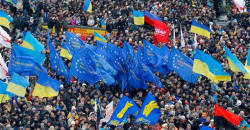|
 Ukraine's
Euromaidan: What's in a name? Ukraine's
Euromaidan: What's in a name?
 Send a link to a friend
Send a link to a friend
[December 02, 2013]
MOSCOW (AP) — Soon after the current
wave of protests arose in Ukraine, a new word appeared to describe them:
Euromaidan. Already in wide use as a hashtag on Twitter, it's an
intriguing invention — linguistically rooted in both East and West,
elusive to translate and an insightful glimpse into the country's
troubled politics. Who coined it isn't clear, and it's become so popular
that it seems almost to have sprung from the collective unconscious.
|
|
 ITS ELEMENTS ITS ELEMENTS
The first part, "Euro," is clear on the surface: Europe. "Maidan" is
obscure to Western ears — it's a word of Persian origin, which
likely entered Ukraine via the Ottomans, meaning "square" or "open
place." However, translating it as "Europesquare" would be
technically accurate but emotionally impoverished because both
elements mean much more.
EUROPE
Ukraine is part of Europe geographically, but for the demonstrators
and their supporters the concept of "Europe" has the resonance of a
vision, vivid and frustratingly out of reach. To them, Europe
implies genuine democracy, trustworthy police and sincere respect
for human rights.

MAIDAN
In this usage, it refers to Maidan Nezalezhnosti (Independence
Square), the central plaza of Kiev. Reconstructed after the
devastation of World War II, the approximately 8-acre square is a
rare Stalin-era public space — neither bleak nor bullying, ringed by
buildings tall enough to be impressive but not intimidating. The
square's agreeable nature echoes in how Kievans talk of it on a sort
of first-name basis: "Let's meet at Maidan."
But as with Europe, Maidan is as much an idea as a place. The square
was the focal point of the Orange Revolution, the 2004 mass daily
protests that forced the annulment of a fraudulent presidential
election. In that role, Maidan became a two-syllable encapsulation
of peaceful resistance and determined action. The symbolism is
powerful enough that Ukrainian media have taken to referring to all
the current demonstrations as Euromaidan, even if they take place on
a "ploshcha," another word for square.
[to top of second column] |

AMBIGUITY
However thrilling the 2004 protests were, the hopes attending to the
spirit of Maidan were largely unrealized. The leaders who came to
power after the demonstrations plunged into years of bitter
quarreling, so severe that the government was frequently paralyzed.
In 2010, disappointed Ukrainians chose Viktor Yanukovych as their
president, the very man who was the nominal winner of the annulled
election in 2004. The heroine of the Orange Revolution, Yulia
Tymoshenko, was thrown into prison after being convicted of abusing
her power while prime minister. In an ironic commentary, Oleksandra
Shevchenko of the topless activist group Femen produced a series of
videos incorporating social commentary and breast-flashing under the
rubric of PMS — Post-Maidan Syndrome.
Euromaidan's ultimate meaning is yet to be fixed — whether it will
come to mean achievement or failure.
[Associated
Press; JIM HEINTZ]
Copyright 2013 The Associated
Press. All rights reserved. This material may not be published,
broadcast, rewritten or redistributed.
 |